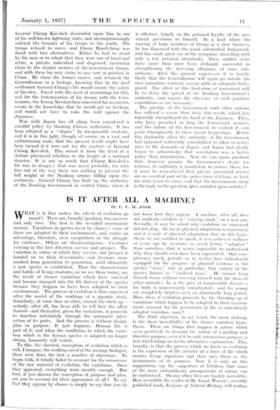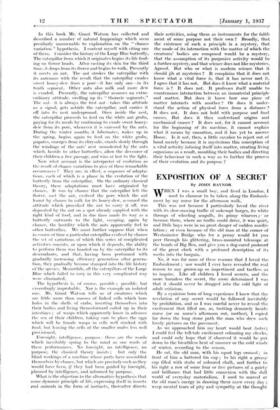IS IT AFTER ALL A MACHINE ?
By C. E. M. JOAD
WHAT is it that makes the wheels of evolution go round ? There are, broadly speaking, two answers and only two. The first is the so-called mechanistic answer. Variations in species occur by chance ; sonic of these are adapted to their environment, and confer an advantage, therefore, over competitors in the struggle for existence. Others arc disadvantageous. Creatures varying in the first direction survive and prosper. The variation in virtue of which they survive and prosper is handed on to their descendants, and becomes more marked from generation to generation, until ultimately a new species is established. Thus the characteristics and habits of living creatures, as we see them today, are the result of chance variations which .have survived and become stamped into the life history of the species because they happen to have been adapted to their environment. The process. of evolution is thus conceived after the model of the workings of a gigantic clock. Somebody, at some time or other, wound the clock up— nobody, after all, has been able to tell how the affair started—and thereafter, given the variations, it proceeds to function indefinitely through the automatic inter- action of its parts. And the process is without design, .plan or purpose. It just happens. Human life is part of it, and when the conditions to which the varia- tion which is the human species is adapted no longer obtain, humanity will vanish.
To this, the classical, conception of evolution which is still, I imagine, the working creed of the average biologist, there were from the first a number of objections. To begin with, it totally failed to account for the occurrence of the raw material of evolution, the variations. Once they appeared, everything went merrily enough. But how, if you disown the conception of purpose and plan, are you to account for their• appearance at all ? To .say that they appear by chance is simply to say that you do not know how they appear. A machine, after all, does not suddenly exfoliate a " varying crank," or a new nut. Secondly, it may be asked why evolution so conceived did not stop. So far as physical adaptation is concerned, and it is only of physical adaptation that on this hypo- thesis we arc entitled to speak, it was achieved millions of years ago by creatures so much better " adaphst " than ourselves, that it scents impossible to understand why they should ever have been superseded. Our com- placency rarely permits us to realise how ridiculously equipped fOr the purposes of physical el istenec is the species " man," and, in particular, that variety of the species known as " civilised man." Ile cannot keep himself warm without covering himself with the skins of other animals ; he is the prey of innumerable diseases ; his body is unnecessarily complicated ; and his young arc completely helpless over an abnormally long period. flow, then, if evolution proceeds by the throwing up of variations which happen to be adapted to their environ- ment, account for the persistence of the so ridiculously adapted variation, man ?
The third objection, to my mind, the most striking, is the sheer incredibility of the chance variation hypo- thesis. There are things that happen in nature which seem positively to demand the notion of a guiding and directive purpose, even if it be Only unconscious purpose, a fact which brings me to the alternative explanation. This, broadly, is that the process which we know as evolution is the expression of the activity of a force of life which creates living organisms and then uses them as the instruments of its purpose. Now it is only on this supposition, say the supporters of Vitalism, that sonic of the more extraordinary arrangements of nature can be understood. On any other they are frankly incredible. How incredible the reader of Mr. Grant Watson's recently published book, Enigmas of Natural History, will realise. In this book Mr. Grant Watson has collected and described a number of natural happenings which seem peculiarly unamenable to explanation on the " chance variation " hypothesis. I content myself with citing one of them. Consider the history of the Large Blue butterfly.
The caterpillar from which it originates begins its life feed- ing on flower heads. After casting its skin for the third time, it drops from its flower and begins to walk. Presently it meets an ant. The ant strokes the caterpillar with its antennae with the result that the caterpillar exudes sweet honey-dew from a pore—it has only one—in its tenth segment. Other ants also milk and more dew is exuded. Presently, the caterpillar assumes an extra- ordinary attitude, swelling up its " thoracic segments." The ant--it is always the first ant—takes this attitude as a signal, gets astride the caterpillar, and carries it off into its nest underground. Once inside the nest, the caterpillar proceeds to feed on the white ant grubs, paying for its meals by continuing to exude sweet honey- dew from its pore, whenever it is caressed by the ants. During the winter months it hibernates, wakes up in the spring, begins again to feed on the white grubs, pupates, emerges from its chrysalis, crawls slowly through the windings of the ants' nest unmolested by the ants which, hostile to other butterflies, allow the devourer of their children a free passage, and wins at last to the light.
Now what account is the interpreter of evolution as the result of chance variations to give of these remarkable occurrences ? They are, in effect, a sequence of adapta. tious, each of which is a phase in the evolution of the butterfly from the caterpillar. On the ordinary classical theory, these adaptations must have originated by chance. It was by chance that the caterpillar left the flower, met the ant, evolved the pore which the ant learnt by chance to milk for its honey-dew, assumed the attitude which provoked the ant to carry it off, was deposited by the ant on a spot already supplied with the right kind of food, and in due time made its way as a butterfly outwards to the light, escaping, again by chance, the hostility which the ants apparently feel to other butterflies. We must further suppose that when in course of time a particular caterpillar evolved by chance the set of variations of which this series of complicated activities consists, or upon which it depends, the ability to perform them was handed on by the caterpillar to its descendants, and that, having been perforined with gradually increasing efficiency generation after genera- tion, they gradually became stamped into the life history of the species. Meanwhile, all the caterpillars of the Large Blue which failed to vary in this very complicated way were eliminated.
The hypothesis is, of course, possible ; possible, but exceedingly improbable. Nor is the example an isolated one. Mr. Grant Watson tells us of creatures which are little more than masses of linked cells which bore holes in the shells of crabs, inserting themselves into their bodies and living thenceforward coiled up in their intestines ; of wasps which apparently know in advance the sex of their children, taking care to place the eggs which will be female wasps in cells well stocked with food, but leaving the cells of the smaller males less well provisioned.
Foresight, intelligence, purpose--these are the words which inevitably spring to the mind as one reads of these performances. No foresight, no intelligence, no purpose, the classical theory insists ; but only the blind workings of a machine whose parts have assembled themselves by chance, but which are precisely such as they would have been, if they had been guided by foresight, planned by intelligence, and informed by purpose.
What is the objection to the alternative hypothesis that sonic dynamic principle of life, expressing itself in insects and animals in the form of instincts, •thereafter -directs their activities, using them as instruments for the fulfil- ment of some purpose not their own ? Broadly, that the existence of such a principle is a mystery, that the mode of its interaction with the matter of which the creatures' bodies are composed would be a mystery, that the assumption- of its purposive activity would lie a further mystery; and that science does not like mysteries. Agreed. But who or what is modern science that it should jib at mysteries ? It complains that it does not know what a vital force is, that it has *never met it. I agree that it has not. But does it know what a material force is ? It does 'not. It professes itself unable to countenance interaction between an immaterial principle and matter. But does it know how one piece of matter interacts with another ? Or does it under- stand the action of physical force from a distance ? It does not. It does not hold with purpose and final causes. But does it then understand origins and mechanical causes*? It does not,- for it cannot account for the . beginning of its machine; it cannot explain what it means by causation, and it has yet to answer Hume. Is it not, then, a little cavalier to reject out of hand merely because it is mysterious this conception of a vital activity infusing itself into matter, creating living organisms as a result, moulding their bodies and directing their behaviour in such a way as to further the process of their evolution and its purpose ?







































 Previous page
Previous page